Hippies!’ screamed fat man in a petrol station. ‘I thought we got rid of you people in the Seventies!’ He had a ‘Trump: Make America Great Again’ sticker on his Dodge Ram, he was wearing a cowboy hat without irony and he almost certainly had a gun. He seemed genuinely repulsed by the sight of us. We looked at each other and had to concede that he had a point.
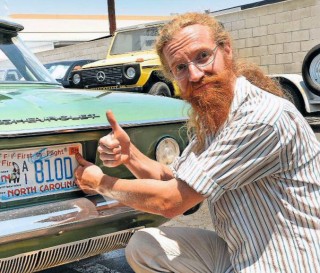
We’d been living in a Chevrolet Corvair for two weeks and we’d just driven across the Mojave Desert – and it showed. Our clothes were soiled with engine oil, beer and brake cleaner and the Corvair was coated in mud, sand and dead insects. We were deep into the most clichéd of road trips: east coast to west coast USA. We’d set out in search of seedy motels, tumbleweed, moonshine, urban decay, rednecks, drive-ins, corn dogs, country music, nodding donkeys, raccoons, xenophobia and furred arteries. We hadn’t been disappointed.
A not very simple plan
The idea was spawned six-months earlier. A broken ankle, a frenzy of internet procrastination and a bank loan led me to purchase the car that topped my non-fantasy dream garage list: a 1960 Chevrolet Corvair saloon. It was in Greensboro, North Carolina. Shipping it home from the east coast was the most logical option, requiring a straightforward 300-mile jolly to Charleston, South Carolina. Shipping it home from the west cost was the least logical option, demanding a hard 3000-mile thrash to Los Angeles, California. I talked options with fellow road trip enthusiast Simon Redrup. It was a no-brainer.
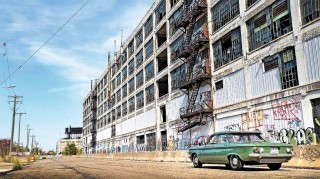
We decided to add 2000 miles by visiting Detroit. The Corvair was an uncommonly fine example but it’d been a low-mileage trailer queen for at least a decade. My customary approach to buying cars abroad is to fly out, lash them together before setting off, fill the boot with spares and carry out unscheduled improvements en route. This time, though, there was a luxury option: delegation.
I’d been introduced to the car’s seller by Steve Avery and Brian Baker, Corvair specialists of high repute in nearby Spartanburg, South Carolina. They took the project under their wing with pleasing persnicketiness. Corvair parts are cheap, so I figured that anything dubious might as well be replaced before the trip, rather than during it. Steve and Brian rebuilt the brake-master cylinder, replaced the slave cylinders, fitted new shoes and filled the system with DOT5. They flushed the fuel tank, replaced the fuel lines, fitted a filter, rebuilt the fuel pump and overhauled the carburettors. They replaced the battery, HT leads, condenser, points, distributor cap, rotor arm and spark plugs They rebuilt the starter motor, interrogated the dynamo, replaced the cooling fan bearing and fitted a new fan belt.
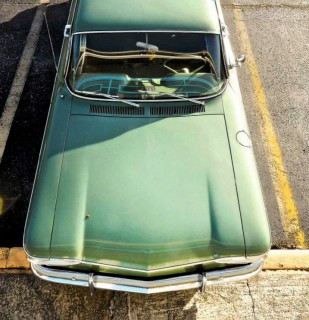
They swapped an incorrect oil pump, fitted new oil pressure and temperature switches, and hoovered dead spiders from the engine’s cooling baffles. They replaced the front wheel bearings, balljoints and bushes, tweaked the steering box and graced the axles with new oil seals, bearings and universal joints.
CENTRE LEFT bizarre cars proliferate at the brilliant Lane Motor Museum, Tennessee.
BOTTOM LEFT Corvair hero Larry Claypool talks fan belts and lubrication points.
Tech tip! A fake date sticker will make an expired USA number plate look legal.
ABOVE Steve Avery and Brian Baker at their ‘Vair workshop.
The Corvair turned out to be almost too good.
Sam says The state of Michigan is a car pervert’s paradise, with a mind blowing number of museums and sites of historical automotive interest. Worth a month in itself.’
They renewed all lubricants, plus the engine oil filter, rear crankshaft oil seal, oil cooler seals and various gaskets. They set the timing, balanced the carburettors and set the idle mixture. They fitted new tyres and treated the car to a few hundred miles of proper use before making final tweaks. Amazingly – and this has never happened to me before – they did all this to an impeccable standard.

Simon and I flew to Baltimore and took an overnight Greyhound bus to North Carolina.
The latter had sounded romantic and exciting when I’d booked it on the internet, but in reality it was a rather unpleasant way to spend 14 hours.
We headed to the Department for Motor Vehicles office in Charlotte. I thought I’d established that we could attain a temporary number plate if I turned up with the Corvair’s title, a bill of sale and certificate of insurance. We couldn’t. After three hours in a sweaty queue, I was told that I also needed a North Carolina driving license. We took defeat on the chin and caught a bus to Spartanburg. ‘We thought you could take the ‘Vair on a test-drive to a pub,’ said Steve, who’s clearly as good as judge of character as he is an engineer. In a strange inversion of convention, the real life than it had looked on the internet.
‘This is way too nice for you,’ Simon mused as I familiarised myself with the kick-down of the two-speed Powerglide transmission. The air-cooled flat-six sounded absolutely magnificent.
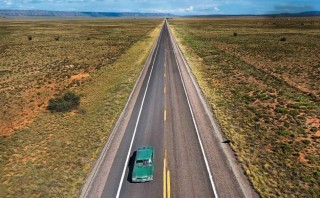
Our hosts were comfortingly dismissive of our failure to get a number plate. ‘The car’s still got the old plate on it,’ Brian reasoned. ‘It’s out of date, but cops in other states won’t know what a North Carolina plate is supposed to look like. If you’re pulled – just be nice!’ I removed incriminating evidence by peeling off the expired date sticker.
The old South
Steve and Brian waved us off, armed with a big box of spares and an emergency survival kit courtesy of Steve Lambert, the car’s charming previous owner. It included cocktail-making impedimenta and a bottle of dangerous-looking local moonshine. Our navigation policy was to stick to B-roads that looked interesting in our small-scale AA road atlas. This was a winning system. The USA’s lumpen proletariat rarely seemed to stray from its dreary but highly effective Interstate network, so we often had the B-roads completely to ourselves.
A gut-churning route across the Smoky Mountains allowed me to get intimately acquainted with the Corvair. I’d always assumed that ‘Vairs handled adequately, choosing to believe the glowing reports of early Sixties motoring journalists, who tended to be accomplished drivers, rather than the sensationalismof Ralph Nader, who didn’t hold a driving licence at the time. I was wrong. The ‘Vair was one the best-handling saloons I’d ever driven.
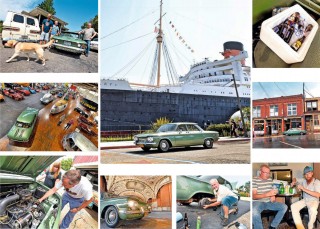
It was stable, pointy and grippy. Like most rear-engined cars, it responded well to smooth but firm driving: settle it carefully on the brakes, point it at the corner and accelerate as soon as possible. ‘You got a watch those things – they’re lethal!’ A man told me in the first petrol station we reached. Similar wisdom was dispensed at almost every subsequent petrol station. Catching and overtaking the advice-givers became a satisfying sport.
We stopped at Nashville, Tennessee, for a poke around the Lane Motor Museum. It’s a source of rampant overstimulation for anyone with a healthy penchant for the weird, wonderful and dismal. ‘Shall we jump in the Dymaxion and grab a kebab?’ suggested Jeff Lane, themuseum’s erudite curator. We assumed he was joking. He wasn’t. It was the most surreal kebab run I’ve been party to.
The Corvair Society of America was holding a rally in Springfield, Illinois – so we gatecrashed. The event was impressive in its scale and its degree of organisation.
Corvairs might seem left-field and eccentric in Europe, but in the USA they’re mainstream classics owned by plenty of perfectly normal people. Not one of these people was Larry Claypool, a lifelong Corvair devotee with a spectacular penchant for blowing up vacuum cleaners by feeding them petrol. We stalked him to his Chicago home. His collection of cars – from AMC Eagle to Zaporozhets 968 (ZAZ 968M) – was immaculately curated. He thoughtfully lent us an in-date sticker to make our number plate look legal.
The bleak Midwest
‘That’s the first car I ever stole!’ barked a grizzled liquor store attendant on the outskirts of Detroit. Motown was exactly as we’d fantasised – a feast of faded grandeur and elegant dereliction. We spent a day cruising dead factories and swathes of post-apocalyptic suburbia. The Packard factory and the Fisher Bodies plant were particularly evocative – both beacons of American automotive prowess now crumbling beyond the point of restorability and inhabited by some terrifying characters. We went on a pilgrimage to the Willow Run factory, where the Corvair had been built 56 years earlier. Most of the 5,000,000 square foot plant was torn down in 2014, but a 144,000 square foot section was heroically rescued by the nearby Yankee Air Museum. Our new rear brake shoes had bedded in and started to wail loudly. We adjusted them in the car park of the excellent Ypsilanti Automotive Heritage Museum. A friendly chap who came to watch us grovelling and swearing turned out to be John Tucker Jr – grandson of Preston Tucker.
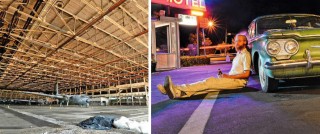
John was a fellow Corvair fetishist and revealed, secretively, that his son is building a car based on the original Tucker Torpedo drawings of maverick designer Alex Tremulis. You heard it here first… It took three long days to waft across Illinois, Iowa and Nebraska on the Lincoln Highway – a historic transcontinental route sucked dry by the opening of the parallel Interstate 80 in the Fifties.
Once-grand trading towns have long-since withered, leaving 1500 miles of straight and spectacularly dull two-lane highway through cornfields.
The Corvair was happy up to 80mph, but its resonant sweet-spot was 64mph. My foot would invariably settle at this speed if left without mental supervision. We dozed, meditated and reflected on existence. We learned fireflies still glow for several seconds after impacting on a windscreen.
The motels we stayed at were rundown and geared more towards residents than passing trade, though their cockroaches were unusually large and sociable. Bars were plentiful and roadside diners were downbeat but entertaining. We were careful not to say anything offensively liberal.
One evening, we noted that the Corvair had sailed past its 3000-mile service interval. We couldn’t find anything worth doing aside from cleaning and gapping the points, adjusting the front brakes and nipping up the front wheel bearings a little.
The (moderately) wild West
We watched drag racing in Denver – an opportunity to observe whooping and hat-waving in its natural habitat – then climbed southwest across the Rocky Mountains. Altitudes in excess of 10,000 feet put a significant crimp on the Corvair’s performance, making long uphill sections a grind. Mild pinking was solved by retarding the timing a couple of degrees. American petrol comes in three grades of wateriness: 87, 89 and 91 octane. Higher grades brought a performance boost at normal altitudes. With fixed-jet carburettors breathing such thin air, however, they made not a shred of difference.
A plan to traverse Pikes Peak was thwarted by a queue of coaches and camper vans. Instead, we drove south to Victor, a still-active and pleasantly grubby gold mining town that doesn’t look like it’s changed much since the 19th Century. It the start of Phantom Canyon Road – 35 miles of gloriously knotted gravel track that follows the route of a long-dead railway. The heavens opened as we set off, turning the surface to slippery red sludge. I suffered a loss of sensibleness and attacked it like a special stage, luxuriating in low-speed oversteer.
The Corvair remained a paragon of composure. Only when far too much speed was carried into corners did its rear become overly pendular.
The route from Pagosa Springs to Kayenta was like something from a John Ford western, the landscape shifting from mountains, to canyons, to full-blown desert. We were forced to deploy our emergency cocktail kit that evening, following the horrifying discovery that the Navajo Indian Reservation still observes a form of prohibition. Route 66 is largely buried beneath Interstate 40, but a few sections are still intact. Seligman to Kingman was pleasant, if a bit of a tourist gauntlet.
Kingman to Topock was marvellous, its sinuousness clearly deterring the duller 90 per cent of holidaymakers. Brain-melting 45°C heat and our inadequate road atlas caused us to get lost in the Mojave Desert. We drove 300 miles to cover 100 as the crow flies. Happily, our beer cooler was freshly-stocked with ice and the Corvair’s engine demonstrated admirable temperature control. Finding ourselves nearby and intrigued by its name we visited Zzyzx, a fascinatingly odd settlement founded as a health spa in the Forties by an eccentric evangelist and now used as a desert studies centre. For similar reasons, we spent the night in Boron – a dusty hellhole so-called because of its proximity to the world’s largest Borax mine.
The final push to Los Angeles began with a rousing thrash across the San Gabriel mountains. These often appear in film scenes involving glamorous people in sports cars, usually ending with nasty accidents. The Los Angeles area is a 1500 square mile concrete grid of traffic jams. It took four hours to fight our way to Long Beach. We were quaffing mojitos on the RMS Queen Mary – now serving as a hotel – by early evening.
Our 5410-mile journey had seemed almost too easy – lacking the breakdowns, arrests and peril that I usually expect in a holiday. It had, however, been fabulous. The Corvair had surpassed all expectations and the USA had proven every bit as excessive, sinister, welcoming, sheltered, fake and spectacular as we’d anticipated. Driving a classic car across the USA might be the world’s cheesiest road trip, but that doesn’t mean everyone shouldn’t do it at least once.
The Boron Motel in Boron, California. Nightlife was limited.
ABOVE A huge and Luxurious boat…and the Queen Mary.
‘Brain-melting 45-degree heat caused us to get lost in the Mojave’
‘The Corvair was stable, pointy and grippy’
TOP The derelict Fisher Bodies plant, Detroit.
LEFT Michigan Theatre, now serving as a car park.
RIGHT John Tucker Jr offers roadside assistance.
BELOW The only remaining section of Willow Run, soon to be an air museum.
Cowboy hats can be worn without irony in the USA.
One of the better preserved sections of historic Route 66 near Seligman, Arizona.
ABOVE Ice liberated from motels made desert driving civilised.
ABOVE Victor, Colorado, resembles a grubby film set.
ABOVE Illegal moonshining in the Navajo Indian Reservation.
Total distance 5410 miles
Driving time 17 days
Petrol burned 1360 litres
Cost of a litre of petrol in South Carolina £0.44
Price of Corvalr £6500
Breakdowns 0
Engine 2288cc/6-cyl/OHV
Power 80bhp @ 4400rpm
Torque 1251b ft @ 2400rpm
Gearbox 2-speed automatic
0-60mph 17.5sec
Top speed 86mph
Fuel economy 19mpg





